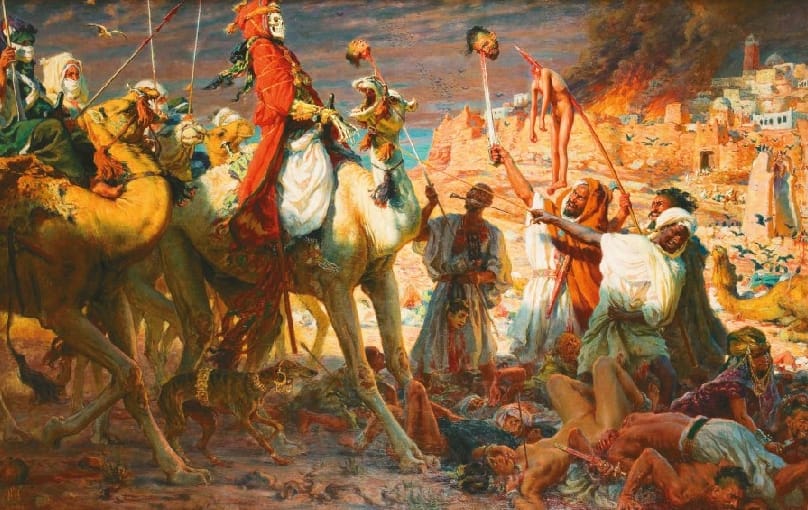For centuries, Arabs freely traded slaves across Africa, the Indian Ocean and the Mediterranean, into every part of the Arab world. However, unlike the Westerners who invested in slavery for its labour benefits, the Arabs pursued a broader range of goals—political, economic, and social. These goals led to one of the most extensive slave trade networks in the history of mankind—the Arab Slave trade. Such was the magnitude of this trade that millions of Africans were captured and traded as slaves for well over a thousand years.
A remarkable feature of the Arab Slave trade was its penchant for the female sex who would be turned into concubines in harems and made to bear children who could ultimately claim freedom as a result of the great value placed on patrilineal descent. Their male counterparts, however, had a more grueling fate as they were most often than not castrated into eunuchs tasked to watch over the harems or sent into the field as labourers.
Over time, these slaves became deeply ingrained into the culture and lifestyle of the Arabs such that they grew in numbers, gained freedom and became a part of the Arab culture. The prevailing beliefs among the Arabs with regards to the “Black” people, however, was not a favourable one which meant that despite the freedom gained, Black Africans remained second class citizens in the Arab world. This belief system is deeply embedded in the documents, literature, and art of the Arab world, where Black individuals are often depicted as demons in fairy tales, described as “lazy, stupid, evil-smelling, and lecherous slaves,” or portrayed as malevolent figures.
Little wonder it is that when a saviour rose up in the Abbasid Caliphate—one of the greatest Muslim empires of the era—against the slave culture that existed in the land, he was supported by thousands of black slaves who saw in him a chance to break free from their oppression and reclaim their dignity.
These slaves were known as the Zanj—East African Blacks—and they would rise to create one of the most profound slave rebellions in the history of mankind—the Zanj Rebellion.
The Zanj People
The root of the word “Zanj” has been attributed to various sources, including Arabic, Persian, and African origins. However, based on its historical usage, it is safe to conclude that the term referred to Black Africans who were brought as slaves into the Abbasid Caliphate, particularly in Iraq.
The Zanj, primarily East Africans, were transported to the southern region of the Abbasid realm by landowners eager to exploit the vast salt marshes near Basra, Iraq. These owners saw the opportunity to transform inhospitable, marshy flatlands—regions like Batiha and Maysan in the lower canal area of Iraq—into fertile farmland. The soil in these districts was perpetually flooded with mud and interlaced with shallow canals choked by swamp reeds, navigable only by small, flat boats. This challenging environment not only necessitated grueling labor, but also offered natural hideaways for brigands and rebels alike, a situation the Zanj would eventually take advantage of.
Before the Abbasids revitalized land reclamation projects, the region around Basra was largely composed of “dead lands.” However, with the backing of capital-rich individuals and reward-bound overseers, the Abbasid state sought to awaken these barren areas. Consequently, thousands of East African slaves were conscripted to remove unproductive surface crusts, transport heaps of soil by mule, and convert these lands into productive fields. Chroniclers note that groups of slaves, sometimes numbering from 500 up to 5,000, were forced to endure this backbreaking work on minimal rations of flour, semolina, and dates. In some accounts, as many as 15,000 slaves labored under these harsh conditions—a stark contrast to the opulence of Basra’s elite, whose wealth and luxury highlighted the bitter social crisis of the era.
Ali Ibn Muhammad
In 869, ʿAlī ibn Muḥammad emerged as a historical figure who led thousands of Zanj slaves in a revolt that temporarily secured their freedom. However, the origins of ʿAlī ibn Muḥammad and the motivations behind his actions remain a mystery to this day.
Alī ibn Muḥammad’s early life shows us that he was a man who claimed descent from Ali, the fourth Caliph, and Fatimah, the daughter of Muhammad. Notably, he embraced the religious principles and doctrines of the Khārijites, an early Islamic sect known for its radical egalitarianism which held that leadership should be based solely on piety and adherence to strict religious criteria, regardless of a person’s social or racial background. For ʿAlī ibn Muḥammad, this meant asserting that even black slaves could be legitimate leaders—a viewpoint that directly challenged the established hierarchies of his time. These ideologies also meant that he branded all opponents as adversaries of a true egalitarian faith.
History indicates that ʿAlī ibn Muḥammad once served as a court poet and instructor in writing, grammar, and astronomy in Samarra (city in Iraq) before leaving for Bahrain (Island situated on the Persian Gulf) around 863–864. In the Bahraini village of Al-Hajar, he began to gather followers but faced internal strife there, which prompted him to move to al-Ahsa—modern-day Saudi Arabia—where he convinced local tribes of his prophetic mission and even assumed the authority to collect taxes in his own name. Though initial attempts to mobilise against the Abbasid Caliphate in these regions met with setbacks, Alī’s ambitions ultimately drew him to Basra.
In Basra, Alī found success under the guise of a wealthy merchant trading in land. During this period, he established key connections, notably with Rayhan ibn Salih, a transporter of flour who played an instrumental role in linking him with the Zanj laborers. In the month of Ramadan, 869, ʿAlī ibn Muḥammad officially proclaimed the revolt by intercepting slave groups en route to their worksites, restraining their overseers, and compelling the enslaved to join his cause. Capitalising on the oppression and injustice they faced, he promised improved conditions and wealth and condemned the old order of slaveholders. This movement ultimately became known as the Zanj Rebellion. For as many as would join the rebellion, Ali promised freedom and prosperity.
This disciplined and resolute leadership not only attracted disaffected slaves but also drew support from poor peasants (Bedouins) and even deserters from the Abbasid army. In his determination, ʿAlī ibn Muḥammad maintained his commitment to the uprising despite offers of pardon and rewards from Abbasid forces, further demonstrating his dedication to the cause of liberation. His egalitarian principles were visibly demonstrated by personal alliances, such as the marriage of one of his daughters to a black slave from Hajar, reinforcing the message that his revolution was a fight against both class-based and racial subjugation.
The revolt
The Zanj rebellion was a terror to the Abbasid caliphate as it wreaked chaos on its political, economic and social existence. Ali and his followers would raid slave groups, condemn their owners and order the emancipated slaves to beat their former masters.
In an attempt to quell the rebellion, various strategies were employed. One of these strategies was the detachment of troops to quell the uprising but the terrain the Zanj rebellion occupied was in their favour as troop after troop were defeated. The rebellion also conquered forces sent from as far as Samarra and Baghdad. Worthy of note, was the rebellion’s strategic use of guerilla war tactics against their opponents. The Zanj demonstrated an adept level of military sophistication through the use of siege-laying catapults, flame-throwers, rapid chariots, and even a modest naval force.
Notably, this success caused the rebellion’s numbers to rise even higher as more slaves took courage and joined. The Abbasid Caliphate also tried negotiations at various intervals. Incentives were offered to Ali, including freedom, total pardon and great rewards. At a point, he was offered five dinars for each slave returned to the Caliphate as well as free passage out of the territory. Ali, however, remained stoic and stood by his emancipated troop.
Over the course of fifteen years, the rebellion gained momentum and strength, ultimately leading to the establishment of six fortified towns equipped with arsenals for manufacturing weapons and warships. This enabled them to sustain prolonged resistance and launch coordinated assaults against Abbasid forces. In 869, the Zanj created a capital city called al-Mukhtarah (the Chosen) — a city built on an inaccessible dry spot in the salt flats. In 870, they successfully attacked and captured al-Uullah (southern Iraq). Subsequently, they seized Ahvaz (a city in southwestern Iran), captured Basra itself in 871, and Wasit in 878. During this period, they established a hold in Khuzistan, Iran. Internally, the Zanj operated with an organized system of communication and intelligence, employing secret codes and coordinated plans that enhanced their ability to mobilize swiftly and strike with precision.
The rebellion dealt a severe blow to the Abbasid Caliphate, disrupting the economy and agriculture, and also crippling trade networks. The caliphate’s major irrigation systems were decimated, leading to widespread agricultural collapse and abandonment of numerous villages. Major cities, including Basra and Wasit, were overtaken and sacked, leaving vast swaths of the region in ruins and depopulated. As revenue streams dried up and the empire’s prestige waned, the caliphate began to fragment, paving the way for emerging regional powers and a rival caliphate that increasingly eroded the Abbasids’ authority, confining them largely to the confines of the capital.
In 883, al-Muwaffaq — a new leader of the Caliphate’s army — became the saviour of the caliphate from the impending doom of the Zanj rebellion. Under his leadership, the Caliphate’s army captured back the cities the Zanj had taken control of and laid a two-year siege on al-Mukhtarah—the Zanjs’ capital city. In 883, this siege was reinforced by Egyptian troops, leading to their victory—a victory marked by the return of the army to Baghdad (the capital city of Iraq) with Ali’s head.
Conclusion
The Zanj Rebellion was not merely a slave revolt but a powerful class uprising that revealed the corrosive effects of unchecked exploitation. It appears that when an economic system devalues human life and enforces brutal labor to enrich a select few, the oppressed will eventually find their collective strength. The Zanj challenge to the Abbasid Caliphate, therefore, can be seen as an early yet potent example of how class struggle can disrupt even the most entrenched regimes—a lesson that continues to resonate through history.

Oluwatetisimi Ariyo
Oluwatetisimi Ariyo is a seasoned writer with extensive experience crafting compelling and conversion-focused content for top global brands.
Leave a Comment
Sign in or become a Africa Rebirth. Unearthing Africa’s Past. Empowering Its Future member to join the conversation.
Just enter your email below to get a log in link.

